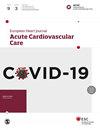Real-world clinical outcome related to veno-arterial extracorporeal membranous oxygenator: a single-center experience
IF 3.9
2区 医学
Q1 CARDIAC & CARDIOVASCULAR SYSTEMS
European Heart Journal: Acute Cardiovascular Care
Pub Date : 2024-05-09
DOI:10.1093/ehjacc/zuae036.153
引用次数: 0
Abstract
Funding Acknowledgements None. Background Veno-arterial extracorporeal membranous oxygenator (VA-ECMO) is one of the most powerful devices that rapidly restore sufficient organ perfusion in patients with cardiogenic shock. Despite abundant experiences of successful resuscitation with VA-ECMO, evidences for clinical benefit of VA-ECMO are still lacking. Purpose We summarised clinical outcomes related to VA-ECMO and investigated predictors regarding survival at discharge. Methods Patients who treated with peripheral VA-ECMO between 2006 and 2022 were included from a Hospital in South Korea. Eligible patients were analysed in stratification with ECMO initiation year (year 2006–2010, year 2011–2016, and year 2017–2022). Survival status at discharge were investigated. Results Among total of 693 patients included, 223 (32.2%) were survived at discharge. Survivors had stayed in hospital for median 28 (19–52) days. The overall volume of ECMO initiation (86 runs vs. 250 runs vs. 357 runs) and the rate of extracorporeal CPR (3.5% vs. 18.4% vs. 38.1%) have increased over time. The median duration of VA-ECMO treatment has increased over time (52.6 hours vs. 63.6 hours vs. 85.8 hours). The serum lactate test has been performed more frequently over time (15.1% vs. 79.6% vs. 99.2%). Among 470 patients who died in the index hospitalization, 154 (32.8%) patients died in the first 24 hours after initiation of VA-ECMO. In a multivariate regression model, age over 70 (OR, 0.54; 95% CI, 0.32–0.89), extracorporeal CPR (OR, 0.42; 95% CI, 0.24–0.71), and lactate level ≥8.0 mmol/L (OR, 0.24; 95% CI, 0.15–0.37) were associated with unfavorable outcome while hemoglobin was a predictor of favorable clinical outcome (OR, 1.16; 95% CI, 1.07–1.25). Conclusion The volume of VA-ECMO has increased and clinical severity has also become higher than before. The rate of survival at discharge after VA-ECMO treatment remains stable; however, the rate of patients who died in the first 24 hours is still high. Age, extracorporeal CPR, hemoglobin and lactate levels were predictors of clinical outcome after VA-ECMO treatment.与静脉-动脉体外膜肺氧合器相关的真实世界临床结果:单中心经验
无。背景 静脉-动脉体外膜氧合器(VA-ECMO)是最强大的设备之一,能迅速恢复心源性休克患者足够的器官灌注。尽管有大量使用 VA-ECMO 成功复苏的经验,但仍缺乏 VA-ECMO 临床获益的证据。目的 我们总结了与 VA-ECMO 相关的临床结果,并调查了出院时存活率的预测因素。方法 纳入韩国一家医院在 2006 年至 2022 年期间接受外周 VA-ECMO 治疗的患者。根据 ECMO 启动年份(2006-2010 年、2011-2016 年和 2017-2022 年)对符合条件的患者进行分层分析。对出院时的生存状况进行了调查。结果 共纳入 693 名患者,其中 223 人(32.2%)出院时存活。幸存者的住院时间中位数为 28 天(19-52 天)。随着时间的推移,启动 ECMO 的总次数(86 次 vs. 250 次 vs. 357 次)和体外心肺复苏率(3.5% vs. 18.4% vs. 38.1%)均有所增加。随着时间的推移,VA-ECMO 治疗的中位持续时间也在延长(52.6 小时 vs. 63.6 小时 vs. 85.8 小时)。随着时间的推移,进行血清乳酸测试的频率越来越高(15.1% 对 79.6% 对 99.2%)。在指数住院期间死亡的 470 名患者中,有 154 名(32.8%)患者在开始使用 VA-ECMO 后的 24 小时内死亡。在多变量回归模型中,70 岁以上(OR,0.54;95% CI,0.32-0.89)、体外心肺复苏(OR,0.42;95% CI,0.24-0.71)和乳酸水平≥8.0 mmol/L(OR,0.24;95% CI,0.15-0.37)与不良预后相关,而血红蛋白则是良好临床预后的预测因子(OR,1.16;95% CI,1.07-1.25)。结论 VA-ECMO 的数量有所增加,临床严重程度也比以前更高。VA-ECMO 治疗后出院时的存活率保持稳定,但在最初 24 小时内死亡的患者比例仍然很高。年龄、体外心肺复苏、血红蛋白和乳酸水平是 VA-ECMO 治疗后临床结果的预测因素。
本文章由计算机程序翻译,如有差异,请以英文原文为准。
求助全文
约1分钟内获得全文
求助全文
来源期刊

European Heart Journal: Acute Cardiovascular Care
Medicine-General Medicine
CiteScore
8.50
自引率
4.90%
发文量
325
期刊介绍:
The European Heart Journal - Acute Cardiovascular Care (EHJ-ACVC) offers a unique integrative approach by combining the expertise of the different sub specialties of cardiology, emergency and intensive care medicine in the management of patients with acute cardiovascular syndromes.
Reading through the journal, cardiologists and all other healthcare professionals can access continuous updates that may help them to improve the quality of care and the outcome for patients with acute cardiovascular diseases.
 求助内容:
求助内容: 应助结果提醒方式:
应助结果提醒方式:


